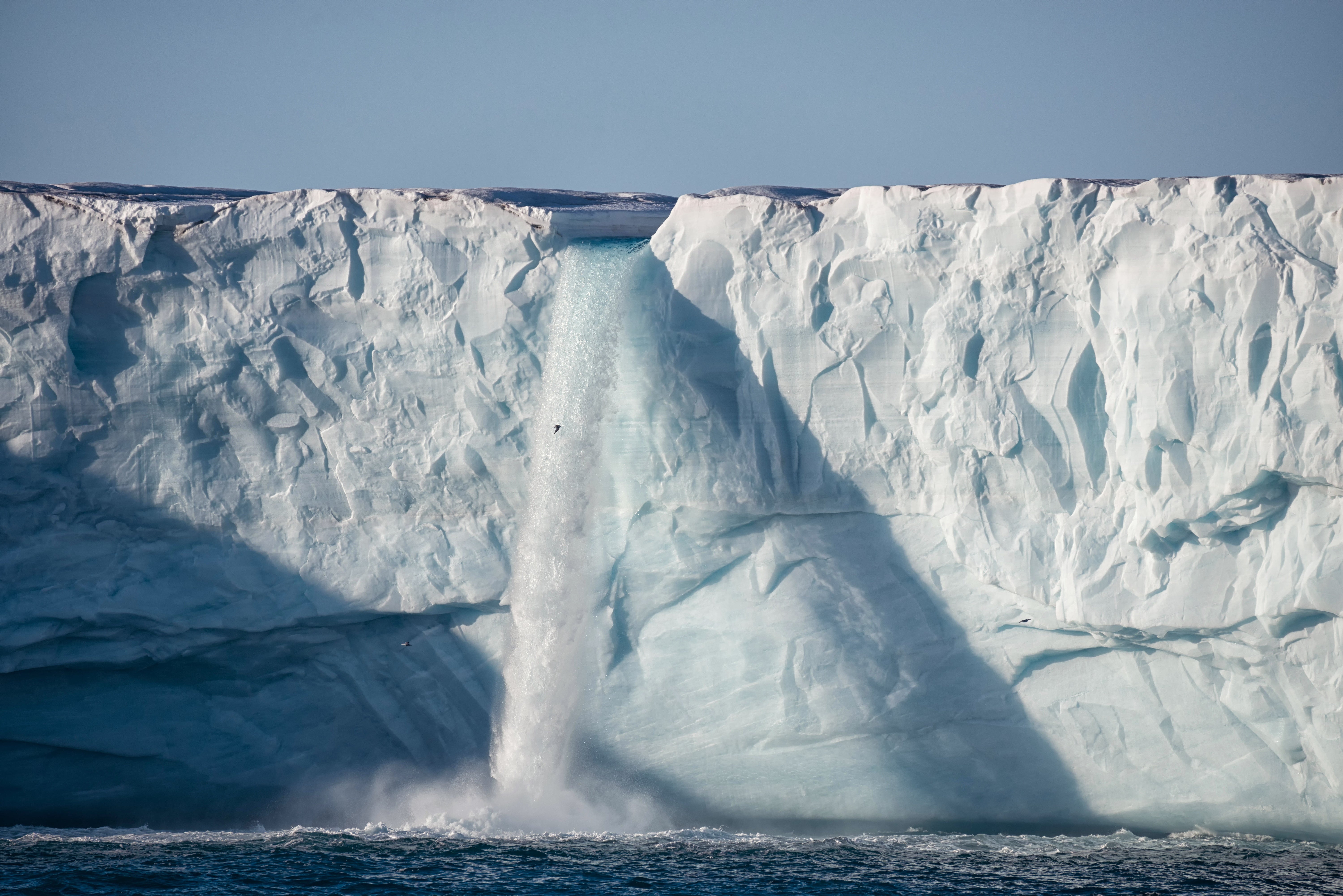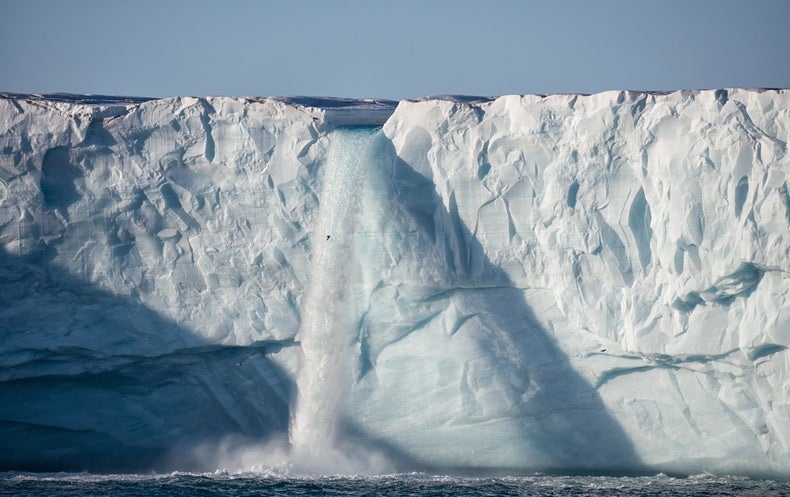
CLIMATEWIRE | One study after another is coming to the same conclusion about the rapidly warming Arctic: It’s heating up a lot faster than earlier research suggested.
The latest figures indicate that the planet’s northernmost region is warming a whopping four times faster than the Earth as a whole.
Scientists have known for years that the Arctic is warming faster than the rest of the planet, a phenomenon known as “Arctic amplification.” But until recently, both scientific papers and news reports have typically reported that temperatures there are rising at about two to three times the global average rate.
A new study, just out yesterday in the journal Communications Earth & Environment, is the latest to weigh in. It finds that the Arctic Circle — the area located above 66.5 degrees latitude — has warmed by more than 5 degrees Fahrenheit since 1979.
In all, the study concludes, the Arctic has warmed at about four times the global average rate over the last 43 years.
“Of course everyone knows that … the Arctic warms faster than the rest of the globe,” said Alexey Karpechko, a scientist at the Finnish Meteorological Institute and a co-author of the new study. “But I think the number — nearly four times that we found now — is simply quite impressive.”
It’s one of several recent studies that have all come to similar conclusions.
A separate group of scientists presented research at the annual meeting of the American Geophysical Union last December with similar findings. And just in June, another study by a different research team also cited a four-times Arctic warming figure (Climatewire, July 11).
The main reason for the update is simple: more data. The rate of Arctic warming has accelerated over time. Older studies relying on earlier time periods may not have fully captured the scale of recent warming.
The study published last month, for instance, found that Arctic warming has increased in uneven jumps over the last few decades. It spiked sharply in the mid-1980s and then again around 1999.
“Arctic amplification was not constant — it really changed in individual decades after 1970,” said Petr Chylek, a researcher at Los Alamos National Laboratory and lead author of the study.
The latest acceleration over the last two decades helped push the Arctic warming rate up to around four times the global average, the study suggests.
The newest study also suggests the rate of Arctic warming varies by season and by geography. It tends to be strongest in the autumn. And it’s also higher above the Arctic Circle. Studies looking at broader geographic regions may find slightly lower warming rates.
All of this means that previous studies citing lower Arctic warming rates weren’t necessarily wrong. They just used earlier datasets or different geographic boundaries.
Mark Serreze, director of the National Snow and Ice Data Center, says he’s often reluctant to “pin a number” on Arctic warming at all. The exact figure is a mutable thing, shifting with different time periods and geographic areas.
Serreze wasn’t involved with the most recent studies, but has researched Arctic warming rates in the past. What’s most important is that the Arctic is warming significantly faster than the rest of the planet as a whole, he says, regardless of the exact number any individual study points to.
“When I see all these numbers coming up there — whether it’s twice as fast as the globe as a whole, three times, four times — I take it with a little bit of a grain of salt,” he said. “That it is warming at an outsized rate, there is no doubt about it.”
‘Not a simple thing’
So why is the Arctic warming so much faster than the rest of the globe? It’s a matter of physics.
Various physical processes are helping rapidly raise temperatures at the top of the world. Melting ice is among the most important.
Much of the Arctic Ocean is covered with a layer of sparkling sea ice. But the sea ice is steadily shrinking as the planet warms — in fact, it’s been declining for decades now. As it disappears, it exposes more of the ocean surface, allowing heat to escape from the warmer water into the colder atmosphere.
It’s a kind of feedback process, raising Arctic temperatures faster and faster as more ice vanishes from the sea.
At the same time, the atmosphere itself is changing in a number of ways as the planet heats up. Some of these changes are altering the ways that heat flows north from the warm equator, affecting Arctic temperatures. These changes can, in turn, affect the speed at which Arctic sea ice melts.
It’s a complicated web of physical mechanisms that all relate to one another, according to Serreze of the National Snow and Ice Data Center.
“The moral of the story is that Arctic amplification is not a simple thing,” he said.
It’s also not likely to last forever.
Some of the feedback processes driving rapid Arctic warming may taper off. Melting sea ice is a prime example.
Large areas of ice are still disappearing and contributing to the Arctic’s swiftly rising temperatures. But eventually, enough ice will vanish that the feedback process will naturally slow down.
“It’s very unlikely that this large Arctic amplification will last for long,” Karpechko said. “Definitely by midcentury we should get lower values, because by that time, we have already lost quite a lot of sea ice.”
If Arctic amplification does slow down in the future, it’s not exactly a cause for celebration. The Arctic region will have fundamentally changed and temperatures will have already risen dramatically. The region will also likely continue on warming — just, perhaps, not at four times the global average.
As Serreze bluntly put it: “What it really means is that it’s freakin’ warm.”
Models versus observations
Scientists use model simulations to make projections about the future of Arctic climate change. And some climate models do suggest that Arctic amplification is likely to slow as sea ice continues to decline.
But there’s a catch: Models, on the whole, might not be completely capturing the scale of Arctic warming or all the processes driving it.
This week’s study finds that climate models tend to underestimate the rate of Arctic warming. It’s still unclear why — but there are a few possible explanations.
It could be that natural climate fluctuations are working alongside the influence of greenhouse gases and human-caused climate change, causing the Arctic’s temperatures to temporarily climb faster than the models predict they should be rising.
Or it could be that the models aren’t capturing some physical process contributing to Arctic amplification. That’s Karpechko’s theory — and if it’s right, it means more research and future improvements to climate models could help solve the problem.
The study “highlights the importance of comparing observations and climate models using a systematic approach to identify ways in which our climate models can be improved,” said Karen Smith, a climate scientist at the University of Toronto, in an email to E&E News. Smith wasn’t involved with the new study, but has researched Arctic amplification in the past.
Improving model simulations of Arctic climate change is important, experts say. They help scientists predict not only the future of the Arctic, but the rest of the world, too.
Human communities and natural ecosystems in the Arctic will be strongly affected by future warming. And studies suggest that Arctic warming may affect weather and climate patterns elsewhere around the globe. It’s important to make sure model projections aren’t underestimating those effects.
“From the Arctic, we can learn what may be waiting for the globe in the next couple decades,” said Chylek, the Los Alamos researcher. “So there’s a reason why everybody is looking into the Arctic.”
Reprinted from E&E News with permission from POLITICO, LLC. Copyright 2022. E&E News provides essential news for energy and environment professionals.

